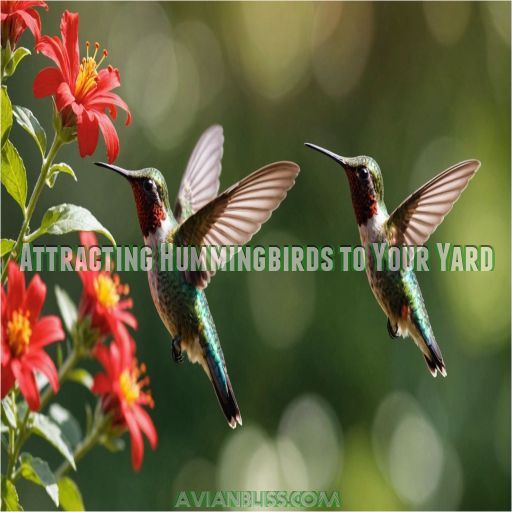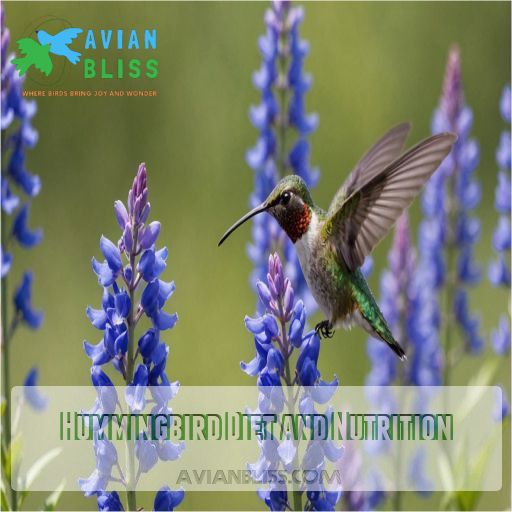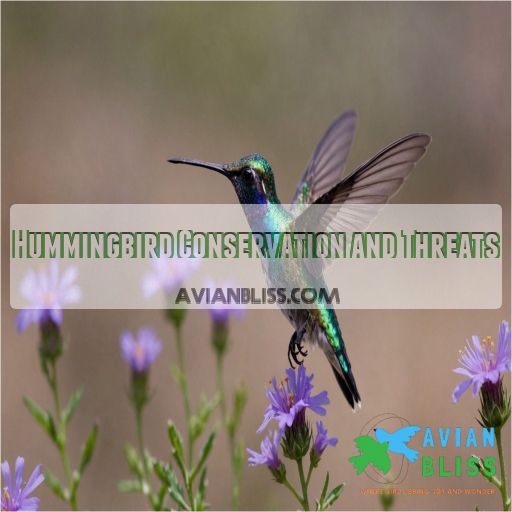This site is supported by our readers. We may earn a commission, at no cost to you, if you purchase through links.

You’ll spot species like the ruby-throated hummingbird, known for their striking plumage, and the feisty rufous hummingbird, a common visitor in the fall.
These tiny powerhouses engage in amazing migration journeys, doubling their body weight for the long trip.
With their incredible speed, agility, and memory, they add a spark of life to any backyard.
Plant nectar-rich flowers, keep feeders clean, and watch the magic unfold.
What’s their secret for figuring out how to travel such vast distances?
Stay tuned to uncover more!
Table Of Contents
- Key Takeaways
- Hummingbirds in Texas
- Hummingbird Species in Texas
- Hummingbird Migration Patterns
- Hummingbird Behavior and Biology
- Attracting Hummingbirds to Your Yard
- Hummingbird Diet and Nutrition
- Hummingbird Nesting and Breeding
- Hummingbird Conservation and Threats
- Hummingbird Viewing and Photography
- Frequently Asked Questions (FAQs)
- What month are hummingbirds in Texas?
- When to put out hummingbird feeders in Texas?
- How do I attract hummingbirds to my feeder in Texas?
- Should a hummingbird feeder be in the shade?
- How do hummingbirds communicate with each other?
- What adaptations help hummingbirds fly backward?
- How do weather patterns affect hummingbird migration?
- What colors attract hummingbirds to feeders?
- How do hummingbirds defend their territory?
- Conclusion
Key Takeaways
- If you want to attract these "feathered jewels" to your Texas garden, plant nectar-rich flowers like standing cypress and keep your feeders clean – think of them as a well-stocked buffet that hummingbirds just can’t resist.
- Watching hummingbirds can be as thrilling as catching a perfect sunset. They are in Texas from spring through fall, with their amazing migrations and vibrant colors lighting up the sky like a living firework show.
- Hummingbirds aren’t just pretty faces; they’re fierce little competitors. They defend their feeding territories with vigor, using rapid wingbeats and bold tactics to keep intruders at bay – these tiny birds are like nature’s own security detail, a testament to their territorial nature.
- With climate change and human impact shaking things up, supporting conservation efforts is key. It helps keep Texas a buzzing hub for these remarkable migrators, ensuring they continue dazzling us with their high-speed antics for years to come.
Hummingbirds in Texas
Spotting a hummingbird in Texas feels like witnessing a tiny athlete zip across your yard.
You might marvel as these colorful flyers pause to sip nectar, showcasing a mix of speed and grace that few creatures can match.
Common Hummingbird Species in Texas
Hummingbird identification in Texas? It’s a breeze! Check out these common species:
- Ruby-Throated: Vibrant and lively.
- Rufous: A feisty beauty.
- Black-Chinned: A frequent flyer.
Time to grab your binoculars!
Distribution and Migration Patterns
Hummingbirds in Texas migrate along distinct routes, with the ruby-throated and black-chinned gracing central and eastern regions, while the rufous passes through the west during its seasonal travels.
Hummingbird Habitat and Distribution
In central Texas, you’ll find hummingbird habitats flourishing in the hill country.
These tiny Texas birds favor areas rich in blossoms and nesting sites.
Keep an eye out for hummingbird sightings near feeders and gardens.
Hummingbird Species in Texas
In Texas, you can find a delightful variety of hummingbird species that will amaze you with their vibrant colors and unique behaviors.
Each species offers a fascinating glimpse into the charm of these tiny, determined creatures.
Whether it’s the ruby-throated or the aggressive rufous hummingbird, each species offers a fascinating glimpse into the charm of these tiny, determined creatures.
Ruby-Throated Hummingbird Characteristics
Ever spot the striking ruby-throated plumage? These Texas birds are famous for their mating rituals, nesting habits, and unique migration patterns
.
Characteristics of the Rufous Hummingbird
The rust-colored, feisty Rufous Hummingbird is a common fall migrant in western Texas, known for its aggressive defense of nectar-rich flowers.
Facts About the Lucifer Hummingbird
Discover the elusive Lucifer Hummingbird in Southwest Texas, a rare bird with a striking purple gorget and distinctive black bill.
- Small size
- Muddy green plumage
- Prefers deserts
- Curved bill
- Shy behavior
Identifying the Broad-Tailed Hummingbird
After marveling at the rare Lucifer Hummingbird, broaden your birdwatching with the Broad-tailed. Spot its pinkish-red throat and shimmery plumage.
Characteristics of the Black-Chinned Hummingbird
Spotting the black-chinned hummingbird is like finding a gem—it’s got a purple gorget. Look for them in southern Texas during mating rituals.
- Breeding Range: Mainly in southern and eastern Texas.
- Territorial Behavior: Fiercely defends feeding zones.
- Nest Location: Prefers shrubs or small trees.
- Mating Rituals: Males perform fascinating aerial displays.
Hummingbird Migration Patterns
As the seasons change, hummingbirds in Texas set off on remarkable migratory journeys, some traveling thousands of miles to reach their wintering grounds in Mexico and Central America.
By doubling their body weight and finding their way with impressive precision, these tiny birds make an incredible feat look effortless.
Migration Routes and Timing
You know, watching hummingbirds in Texas isn’t just about their vibrant plumage. Keep an eye out for their spring arrival and fall departure along overland routes or Gulf crossings!
Preparing for Migration
To fuel up for migration, hummingbirds double their weight. Consider:
- Providing energy-rich nectar.
- Ensuring fresh water.
- Observing weather patterns.
- Supporting nesting habits. They’re nature’s athletes!
Wintering Grounds and Longevity
As hummingbirds journey to their wintering grounds in Mexico and Central America, their incredible lifespan of around five years seems like a blink. Conservation helps mitigate threats.
Life Cycle and Reproduction
Hummingbirds return faithfully to their nesting sites year after year, weaving intricate nests and raising their tiny, jellybean-sized chicks with tireless devotion.
Hummingbird Behavior and Biology
Explore the fascinating ways hummingbirds in Texas navigate and remember their environment while still having time to engage in social sparring matches.
You’ll be amazed at their incredible speed and agility, driven by some of the tiniest yet mightiest brains in the bird world.
Unique Characteristics and Abilities
You’ve just marveled at their migrations. Now, meet the hummingbird: Nature’s acrobat, flaunting hovering and backward flight, hyperactive tongue mechanics, massive brain power, and sky-high metabolism!
Flight Speed and Navigation
These tiny aviators soar faster than a sneeze on a windy day, zipping through the skies at impressive speeds to master migration challenges with evolutionary precision and grace.
Memory and Learning
Their exceptional memory allows hummingbirds to efficiently locate nectar sources and remember migration routes, showcasing their impressive spatial learning abilities and foraging strategies.
Social Behavior and Communication
While tiny, hummingbirds pack a punch with territorial defense. They engage in courtship displays, communication calls, and feeding interactions, ensuring nest defense. They’re small but mighty defenders!
Attracting Hummingbirds to Your Yard
Attracting hummingbirds to your Texas yard is about creating a nectar-rich paradise they’ll never want to leave, especially if you provide a winter haven.
With colorful flowers and well-maintained feeders, you might just make them think your yard’s the hottest hummingbird hangout in the neighborhood!
Planting Nectar-Rich Flowers and Herbs
To attract hummingbirds, consider planting nectar-rich flowers like standing cypress and mints. These selections delight hummingbirds and beautifully enhance your garden design.
Using Hummingbird Feeders and Nectar
Craft your own nectar blend, hang feeders in shaded spots, and clean them regularly to provide hummingbirds a safe, nutritious pit stop in your backyard oasis.
Creating a Hummingbird-Friendly Environment
Let’s move beyond just feeders. Create a hummingbird-friendly haven by including:
- Colorful native plants
- Fresh water sources
- Garden design with shelters
- Using natural resources effectively
Avoiding Pesticides and Predators
Imagine your yard as a haven for hummingbirds. Ditch chemical pesticides. Embrace natural deterrents to keep predators at bay. Aim for hummingbird-safe gardening for habitat protection.
Hummingbird Diet and Nutrition
Fuel your yard’s hummingbird visits by understanding their diet—nectar is essential, but these tiny visitors also need insects for protein.
Imagine the high energy it takes to flap wings that fast; you’ll want to think of them as nature’s little sugar addicts with a side order of bugs!
Importance of Nectar and Insects
Nectar is the lifeblood of hummingbirds, providing essential sugars for their boundless energy.
But insects offer important protein to support their rapid growth and metabolism.
A balanced diet of:
- Flower nectar
- Tree sap
- Small spiders and insects
- Pollen
ensures these tiny wonders thrive.
Providing a Balanced Diet
Like mixing a cocktail, providing a balanced diet for hummingbirds requires precision. They thrive on nectar sources and insect diversity.
| Ingredient | Proportion |
|---|---|
| Sugar Water | 1 part sugar |
| Natural Nectar | High |
| Insect Protein | Essential |
| Feeder Maintenance | Regular |
| Seasonal Changes | Monitored |
A happy hummer’s feast! Marvel at their energetic dance.
Hummingbird Nesting and Breeding
In Texas, hummingbirds are master architects, constructing tiny nests from plant fibers and spider silk with the skill of a DIY enthusiast.
Tiny warriors fiercely defend their family nests as they court, mate, and raise their chicks, it’s like witnessing a mini soap opera.
Nesting Materials and Construction
Moving from their diet to their homes, hummingbirds craft nests using plant fibers and spider silk. Camouflage strategies are excellent, making these tiny nests nearly invisible.
Breeding and Mating Habits
The males’ vibrant courtship displays captivate females, who carefully select their mates. Hummingbirds fiercely defend their nesting territories, weaving intricate homes with plant fibers and spider silk.
Incubation and Fledging
After hummingbirds select mates, it’s all about parenting! Females incubate tiny, pinto bean-sized eggs for up to 18 days, nurturing future dazzling fledglings. Chick survival relies on attentive care.
Nesting Sites and Protection
In choosing nesting sites, hummingbirds favor secluded branches or sheltered spots. To protect from nest predation and habitat threats, consider human impact and support ongoing conservation efforts.
Hummingbird Conservation and Threats
You’ll find that conserving hummingbirds in Texas is essential due to threats like habitat loss and climate change affecting their migration.
Hummingbirds are facing challenges, but we can help these tiny, feisty birds keep buzzing around by supporting conservation efforts and tackling human impacts.
Habitat Loss and Fragmentation
Sadly, urban sprawl and habitat fragmentation threaten hummingbirds. To help, plant native flowers, avoid pesticides, and support conservation efforts in your community.
- Protect remaining natural habitats
- Restore native vegetation and nectar sources
- Reduce pesticide use in your yard
- Support local conservation organizations
- Educate others about hummingbird conservation
Climate Change and Migration
Climate change impacts hummingbirds like a rolling stone gathering no moss. As migration routes shift with changing seasons, breeding times encounter confusion. Thoughtfully address these unpredictable changes.
Predation and Human Impact
A hummingbird’s tiny predators, habitat loss, and window strikes can spell trouble. Imagine sipping nectar and—bam! A window. Avoiding pesticide use helps these dazzling flyers flourish.
Conservation Efforts and Organizations
Hummingbird sanctuaries and Texas conservation groups are saving the day. Join citizen science projects to protect habitats and combat threats to hummingbirds with habitat restoration efforts.
Hummingbird Viewing and Photography
Witnessing the mesmerizing dance of hummingbirds up close is a true delight.
Whether you’re aiming to capture their beauty through a lens or simply enjoy their enchanting presence, this section offers expert tips to make the most of your hummingbird viewing experience, keeping ants away from your feeder.
Tips for Hummingbird Viewing
Watching hummingbirds is like waiting for a rainbow to appear. Find the best viewing spots, respect their space, carry binoculars, and let patience play its beautiful tune.
Hummingbird Photography Techniques
Capturing hummingbirds requires patience and skill. Set your camera settings high for motion. Lighting challenges need cunning solutions, while composition tips demand understanding bird behavior intricacies.
Best Times and Places for Viewing
For the best hummingbird viewing spots, visit Texas hummingbird hotspots during migration season in late summer. Attend Texas Hummingbird Festivals for unforgettable encounters with these tiny wonders.
Hummingbird Behavior and Body Language
Your keen eye can spot a hummingbird’s courtship dances, their fierce territorial squabbles, and their mesmerizing hovering. Listen closely for their unique chirps and trills too.
Frequently Asked Questions (FAQs)
What month are hummingbirds in Texas?
Ah, the hummingbirds – nature’s tiny, feathered acrobats!
These winged wonders grace Texas skies from spring through fall, with their dazzling displays and insatiable appetites.
So keep your eyes peeled, for these high-flying harbingers of warmer days are always on the move!
When to put out hummingbird feeders in Texas?
Start hanging your hummingbird feeders in Texas around mid-March.
Those little helicopter birds begin their northern migration like the Bohemian Waxwing,
and your sweet nectar will be like a beacon, attracting them for a pit stop on their journey.
How do I attract hummingbirds to my feeder in Texas?
Despite hummingbirds’ penchant for speed, turning your feeder into a buzzing hotspot involves juicy nectar-rich red flowers and a sugar solution.
Maintain a clean feeder and ditch the dyes; they seek sweetness, not artificial allure.
Should a hummingbird feeder be in the shade?
Place your hummingbird feeder in a shady spot, like you’re giving them a cozy umbrella.
It helps keep the nectar cooler, reducing spoilage.
This gives hummingbirds a comfortable place to sip and mingle.
How do hummingbirds communicate with each other?
Hummingbirds communicate through a variety of high-pitched chirps, trills, and buzzes.
They also use body language like head bobs and wing flicks to signal territory, courtship, and aggression.
It’s a fascinating language you can learn to understand.
What adaptations help hummingbirds fly backward?
You won’t believe it, but hummingbirds fly backward thanks to their unique ball-and-socket shoulder joints.
This allows incredible wing rotation, like a mini helicopter, enabling them to soar in any direction with ease and grace.
How do weather patterns affect hummingbird migration?
Weather patterns are the invisible hands guiding hummingbird migrations.
With warm breezes pushing them forward, it’s like surfing on air currents.
But fierce winds can be a cage rattler, delaying your flight and making nectar harder to find (Source).
What colors attract hummingbirds to feeders?
Though birds can’t smell, they’d never miss red and orange feeders.
They flock to them like bees to honey, favoring the vibrant hues.
Remind them you’re serious by filling feeders with fresh nectar!
How do hummingbirds defend their territory?
Hummingbirds fiercely defend their territories, chasing away intruders with rapid wing beats, sharp calls, and even physical attacks.
They’ll dive-bomb predators like crows and hawks to protect their nectar-rich feeding grounds and nesting sites.
Conclusion
Did you know that hummingbirds can flap their wings over 50 times per second?
These lively creatures, like those you find among the hummingbirds in Texas, are truly one of nature’s marvelous wonders.
By creating a welcoming environment with nectar-rich plants and clean feeders, you can invite these fascinating birds into your yard. hummingbird feeder tips.
Their unique migration and engaging behavior promise endless enjoyment and inspiration.
So, get ready to experience the wonder that hummingbirds bring to Texas!








0 Comments